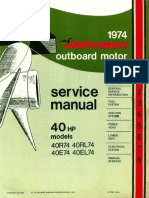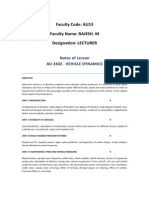0%(1)0% found this document useful (1 vote)
4K viewsThe Car Aerodynamics Quiz
The Car Aerodynamics Quiz
Uploaded by
tarif ashtarThe document is a quiz about car aerodynamics. It covers topics like drag, pressure differences around a moving car, boundary layers, downforce, drafting, wings, diffusers, and minimizing drag. The questions test understanding of key aerodynamic concepts that influence a car's performance, such as how spoilers, splitters, and wings affect air pressure and downforce.
Copyright:
© All Rights Reserved
Available Formats
Download as DOCX, PDF, TXT or read online from Scribd
The Car Aerodynamics Quiz
The Car Aerodynamics Quiz
Uploaded by
tarif ashtar0%(1)0% found this document useful (1 vote)
4K views4 pagesThe document is a quiz about car aerodynamics. It covers topics like drag, pressure differences around a moving car, boundary layers, downforce, drafting, wings, diffusers, and minimizing drag. The questions test understanding of key aerodynamic concepts that influence a car's performance, such as how spoilers, splitters, and wings affect air pressure and downforce.
Original Description:
The Car Aerodynamics Quiz
Copyright
© © All Rights Reserved
Available Formats
DOCX, PDF, TXT or read online from Scribd
Share this document
Read this document in other languages
Did you find this document useful?
Is this content inappropriate?
The document is a quiz about car aerodynamics. It covers topics like drag, pressure differences around a moving car, boundary layers, downforce, drafting, wings, diffusers, and minimizing drag. The questions test understanding of key aerodynamic concepts that influence a car's performance, such as how spoilers, splitters, and wings affect air pressure and downforce.
Copyright:
© All Rights Reserved
Available Formats
Download as DOCX, PDF, TXT or read online from Scribd
Download as docx, pdf, or txt
0%(1)0% found this document useful (1 vote)
4K views4 pagesThe Car Aerodynamics Quiz
The Car Aerodynamics Quiz
Uploaded by
tarif ashtarThe document is a quiz about car aerodynamics. It covers topics like drag, pressure differences around a moving car, boundary layers, downforce, drafting, wings, diffusers, and minimizing drag. The questions test understanding of key aerodynamic concepts that influence a car's performance, such as how spoilers, splitters, and wings affect air pressure and downforce.
Copyright:
© All Rights Reserved
Available Formats
Download as DOCX, PDF, TXT or read online from Scribd
Download as docx, pdf, or txt
You are on page 1of 4
The Car Aerodynamics Quiz
1. The term used to define and measure the air
resistance acting against a moving car is…
coefficient of drag
lemniscate of Bernoulli
frictional eigenvalue
2. Imagine a moving car. The area directly in front of
the car is an area of…
lower air pressure
higher air pressure
a perfect vacuum
3. What happens when air struggles to fill the void
left behind a car that's moving forward?
The low pressure area behind the car "pulls" on the car, creating drag.
The air rushes into the void and pushes the car forward.
The low pressure area creates lift that reduces the traction of the rear tires.
4. What is the term for air molecules that behave in a
chaotic manner, moving in multiple directions
instead of a consistent flow?
turbulence
resistance
drafting
5. What is it called when air molecules break away
from the car's surface and become turbulent?
flow separation
delamination
the Venturi effect
6. What is the name for the layer of air molecules
that forms along the surfaces of a moving object,
such as a car?
viscosity layer
boundary layer
diffusion layer
7. Which part of a car's bodywork helps create an
area of low pressure underneath the car?
windshield
rear spoiler
front splitter
8. What is the optimal cross-sectional shape for
suspension components that are exposed to the air
(such as in open wheel race cars)?
round
oval
square
9. Along with coefficient of drag, the most important
aerodynamic aspect of a car's shape is…
frontal area
height
roof curvature
10. The best shape for a car's rear window is…
a flat panel that angles in toward the passenger compartment
a flat vertical panel
a gradual slope
11. What helps create an area of high pressure over
a car's trunk, negating the low pressure created by
the rear window?
a wing
a spoiler
brake cooling vents
12. Does a wing on a race car act the same as a wing
on an airplane?
Yes, but a wing on a car is inverted to provide downforce instead of lift.
No, it's a misconception that they perform similar functions because they
were given similar names.
Yes, but other parts of the car's design must work to overcome the lift
created by the wing.
13. Which of these does NOT help create low air
pressure underneath a car?
a raked angle, with the front of the car closer to the ground than the rear
ram air intake on the hood
side skirts
14. Why does the trailing car gain speed when
"drafting" another car (or truck)?
It's riding the wave of turbulence created by the lead car.
It's driving in the low pressure area created by the lead car and therefore
doesn't have to push through as much air.
The flow separation from the lead car pushes more air into the trailing car's
engine, increasing the horsepower.
15. A wing with an aggressive angle of attack
generates both downforce and…
lift
drag
the Venturi effect
16. NACA ducts can be used to reduce what?
lift
frontal area
the size of the boundary layer
17. What does a rear diffuser do?
seal off the area beneath the car, keeping all air flow out
expand the area under the car, accelerating the movement of air out from
under the car, increasing downforce.
dissipate turbulence from the wheel wells
18. As a car's velocity doubles, what happens to the
amount of drag it experiences?
It remains the same.
It quadruples.
It increases ten times.
19. What is a potential problem when a race car
drafts another car very closely?
reduced fuel efficiency
over-revving the engine
overheating
20. To minimize drag, elements that project from the
main body of the car, like mirrors, should be
placed…
very close to the main body
as far from the body as is practical
in front of a wing or spoiler
You might also like
- Diana's 30-Day Ab Challenge 2Document2 pagesDiana's 30-Day Ab Challenge 2Carolina SanchezNo ratings yet
- 1974 Johnson 40HP Outboards Service Manual PDFDocument4 pages1974 Johnson 40HP Outboards Service Manual PDFChrisStainton33% (3)
- Introduction To Automobile EngineeringDocument36 pagesIntroduction To Automobile EngineeringArindom NagNo ratings yet
- Carburetors Test Answer SheetDocument5 pagesCarburetors Test Answer SheetElio Alexander Mora Sayago100% (1)
- Internal Combustion Engines MCQ PDFDocument14 pagesInternal Combustion Engines MCQ PDFShakir ullah87% (53)
- Design Optimisation of Space Frame ChassisDocument40 pagesDesign Optimisation of Space Frame Chassisadj adj100% (1)
- The Death MatchDocument10 pagesThe Death MatchJulius Cesarion100% (1)
- PF 31011 Pullup User GuideDocument10 pagesPF 31011 Pullup User GuideShankar AnandNo ratings yet
- Aerodynamicsincars 161230074555 PDFDocument23 pagesAerodynamicsincars 161230074555 PDFHsbsbdNo ratings yet
- Nptel: Vehicle Dynamics - Video CourseDocument2 pagesNptel: Vehicle Dynamics - Video CourseManoj BENo ratings yet
- Recent Trends in Automobile & Mechanical-1 PDFDocument76 pagesRecent Trends in Automobile & Mechanical-1 PDFYsb100% (2)
- Aerodynamic Analysis of A Car PDFDocument110 pagesAerodynamic Analysis of A Car PDFdhirendarji100% (1)
- At 6501 MCQDocument97 pagesAt 6501 MCQrajmehaNo ratings yet
- Automobile Engineering ObjectivesDocument15 pagesAutomobile Engineering ObjectivesArash Vir Singh Jamwal100% (1)
- Unit 4Document8 pagesUnit 4Dipak ZopeNo ratings yet
- 250 TOP I.C. Engines - Mechanical Engineering Multiple Choice Questions and Answers List - MCQs Preparation For Engineering Competitive ExamsDocument45 pages250 TOP I.C. Engines - Mechanical Engineering Multiple Choice Questions and Answers List - MCQs Preparation For Engineering Competitive Examsthejaraju_r50% (4)
- Automobile Unit-4.Wheels & TyresDocument18 pagesAutomobile Unit-4.Wheels & TyresRajesh Jagadeesan60% (5)
- Automobile Technical QuestionsDocument5 pagesAutomobile Technical QuestionseswarlalbkNo ratings yet
- Ae MCQDocument12 pagesAe MCQYuvraaj Singh100% (3)
- Auto - Question Bank PDFDocument4 pagesAuto - Question Bank PDFcharulapNo ratings yet
- Automobile EngineeringDocument5 pagesAutomobile EngineeringINAMUL HASANNo ratings yet
- At2402 NotesDocument7 pagesAt2402 NotesAnonymous ETBwIduGiNo ratings yet
- Engine Emissions ControlDocument6 pagesEngine Emissions ControlGabriel25% (4)
- Vehicle Dynamics - Thomas DDocument38 pagesVehicle Dynamics - Thomas DJasbir Singh Dhanoa100% (1)
- Vehicle Dynamics For Racing GamesDocument18 pagesVehicle Dynamics For Racing GameskrishnasrikanthNo ratings yet
- Automobile Engineering Mcqs Set6 - Preparation For Gate ExamsDocument7 pagesAutomobile Engineering Mcqs Set6 - Preparation For Gate ExamsUpender DhullNo ratings yet
- Forward Vehicle Dynamics - 1Document24 pagesForward Vehicle Dynamics - 1warcellNo ratings yet
- Vehicle Dynamics Course Plan 2019Document11 pagesVehicle Dynamics Course Plan 2019Girish ChandranNo ratings yet
- Worksheet 4 PDFDocument2 pagesWorksheet 4 PDFtewodrosNo ratings yet
- Analysis of Flow Over Passenger Cars Using ComputaDocument8 pagesAnalysis of Flow Over Passenger Cars Using Computahung phungNo ratings yet
- Auto MCQDocument192 pagesAuto MCQAMOL JAGTAP100% (3)
- Transport Management and Motor Vehicle ActDocument4 pagesTransport Management and Motor Vehicle ActSamarth PatilNo ratings yet
- IC Engines Theory - Mission IESDocument17 pagesIC Engines Theory - Mission IESDell AsusNo ratings yet
- MCQDocument5 pagesMCQSathis Kumar67% (12)
- Assistance Motor Vehicle Inspector QuestionsDocument9 pagesAssistance Motor Vehicle Inspector Questionstony_reddyNo ratings yet
- Objective QuestionsDocument16 pagesObjective QuestionsBhardwaj Rajinder Sippy100% (2)
- 300+ TOP Automobile Engineering Multiple Choice Questions Answers PDFDocument27 pages300+ TOP Automobile Engineering Multiple Choice Questions Answers PDFer9824925568100% (1)
- 2 Marks Question With AnswersDocument16 pages2 Marks Question With AnswersmohanmzcetNo ratings yet
- Selecting Automotive Diffusers To Maximise Underbody DownforceDocument18 pagesSelecting Automotive Diffusers To Maximise Underbody DownforceVyssion100% (1)
- Layout of Chassis & Types of Drives of AutomobilesDocument12 pagesLayout of Chassis & Types of Drives of Automobilesrajmeha67% (3)
- 02 Coordinate SystemsDocument2 pages02 Coordinate Systemskhiladi2No ratings yet
- Vehicle Body EngineeringDocument2 pagesVehicle Body EngineeringNikhil Garg25% (8)
- FSAE Design and OptimizationDocument51 pagesFSAE Design and OptimizationLizHuangNo ratings yet
- Automobile Engineering MCQDocument9 pagesAutomobile Engineering MCQVigneshwar VNo ratings yet
- LV04 Paper 2 TestDocument3 pagesLV04 Paper 2 TestBob CooperNo ratings yet
- Suspension Systems and ComponentsDocument90 pagesSuspension Systems and Componentsmaheshgarg81100% (2)
- HEV Multiple Chioice, Mid-1Document14 pagesHEV Multiple Chioice, Mid-1KURAKULA VIMAL KUMARNo ratings yet
- Ic Engines ApptitudeDocument39 pagesIc Engines ApptitudekarthiyuvenNo ratings yet
- Worksheet For Finding Tyre RateDocument1 pageWorksheet For Finding Tyre RatePrasadHd100% (1)
- A New Aerodynamic Approach To Advanced Automobile Basic ShapesDocument13 pagesA New Aerodynamic Approach To Advanced Automobile Basic ShapesVyssion100% (1)
- Unit I:: Design of Vehicle Body For SafetyDocument47 pagesUnit I:: Design of Vehicle Body For Safetyduraisvce78% (9)
- LHR EngineDocument31 pagesLHR Enginesarathkumar100% (2)
- AT - Transmission - MCQDocument4 pagesAT - Transmission - MCQJackson A MNo ratings yet
- Unit 2 - Automobile Suspension System: 1-Leaf Springs Absorb Shocks byDocument5 pagesUnit 2 - Automobile Suspension System: 1-Leaf Springs Absorb Shocks byDipak ZopeNo ratings yet
- 2.0. Aerodynamics, Ergonomics & ComfortDocument63 pages2.0. Aerodynamics, Ergonomics & ComfortSundhar SavariNo ratings yet
- Aerodynamics in CarsDocument23 pagesAerodynamics in CarsChellaGaneshNo ratings yet
- Aerodynamics Related To ChassisDocument23 pagesAerodynamics Related To ChassisAmal MechanicNo ratings yet
- How Does Aerodynamics Dictate Formula OneDocument8 pagesHow Does Aerodynamics Dictate Formula OnekrittametsupmunNo ratings yet
- Aerodynamics in Car DesignDocument24 pagesAerodynamics in Car Designgouthamsuresh009No ratings yet
- VBE Unit 2 Notes PDFDocument43 pagesVBE Unit 2 Notes PDFYash GargavNo ratings yet
- Aerodynamic Car Technical SeminarDocument30 pagesAerodynamic Car Technical SeminarTigerSrinivasanNo ratings yet
- Aerodynamics of Formula1 CarDocument12 pagesAerodynamics of Formula1 CarRONAK ARORANo ratings yet
- Aerodynamic Cars Science 5616Document19 pagesAerodynamic Cars Science 5616mohammad faisal100% (1)
- Aerodynamic Cars ScienceDocument19 pagesAerodynamic Cars ScienceAtul KumarNo ratings yet
- There Is A Party Today Grammar Drills Information Gap Activities Picture - 92015Document3 pagesThere Is A Party Today Grammar Drills Information Gap Activities Picture - 92015Anonymous bka3xL6No ratings yet
- Middle-Earth: Against The Shadow : Came (MECCG) ProductsDocument3 pagesMiddle-Earth: Against The Shadow : Came (MECCG) ProductsfurrygooberNo ratings yet
- Activating Adaptation 2Document7 pagesActivating Adaptation 2Nisse WollmerNo ratings yet
- Anterior Abdominal Wall Lecture - Nov2015Document75 pagesAnterior Abdominal Wall Lecture - Nov2015Nithin0% (1)
- Orthopaedics FinalDocument124 pagesOrthopaedics Finaldbchoudhary77No ratings yet
- 10 Philippine Legends in AthleticsDocument3 pages10 Philippine Legends in AthleticsTreks BrionesNo ratings yet
- Conect OresDocument138 pagesConect OresRZ EmiNo ratings yet
- Baby Merc Catalogue 2015.2016Document33 pagesBaby Merc Catalogue 2015.2016Gyöngyvér Major VeresNo ratings yet
- Meaningless War 0091 - Mobile Suit Gundam Another StoryDocument1 pageMeaningless War 0091 - Mobile Suit Gundam Another StoryMark AbNo ratings yet
- EW Opus Software ManualDocument130 pagesEW Opus Software ManualluciorebelloNo ratings yet
- Zerona Laser For Weight ManagementDocument4 pagesZerona Laser For Weight ManagementTapovan WellnessNo ratings yet
- Youngstown State University Open/High School Meet #2Document16 pagesYoungstown State University Open/High School Meet #2DanNo ratings yet
- Pe Edit Body MovementDocument3 pagesPe Edit Body MovementShaira Mae Bautista HabelNo ratings yet
- Gaming America - November-December 2019Document36 pagesGaming America - November-December 2019James OaksNo ratings yet
- Blackhawk Holster Fit ChartDocument2 pagesBlackhawk Holster Fit ChartFrancisco LopezNo ratings yet
- Atv Recuperação 9 AnooDocument2 pagesAtv Recuperação 9 AnooCesar Vieira100% (1)
- Cummins Engine Datasheet: Engine Model 4Bt3.9-G2 Performance Curve FR L003Document5 pagesCummins Engine Datasheet: Engine Model 4Bt3.9-G2 Performance Curve FR L003Encep Zaenal MNo ratings yet
- Parts of Speech: Nouns vs. Verbs: Super Teacher WorksheetsDocument2 pagesParts of Speech: Nouns vs. Verbs: Super Teacher WorksheetsWilliam GeorgeNo ratings yet
- Be The Fittest - Tyrone BrennandDocument344 pagesBe The Fittest - Tyrone Brennandjayafeb692No ratings yet
- Curl, Fluid Rotation in Three Dimensions (Article) - Khan AcademyDocument28 pagesCurl, Fluid Rotation in Three Dimensions (Article) - Khan Academyندى عمريNo ratings yet
- Spec NLR 45-150Document4 pagesSpec NLR 45-150TheTalentNo ratings yet
- Final Physics Year 10Document21 pagesFinal Physics Year 10PeterNo ratings yet
- Girl T-Shirt RobloxDocument1 pageGirl T-Shirt Robloxresurrection786No ratings yet
- Camaro 3.6L 2011 - Distribuição de Positivos Fusíveis PDFDocument5 pagesCamaro 3.6L 2011 - Distribuição de Positivos Fusíveis PDFjunior balada100% (1)
- Nethermiss 2Document2 pagesNethermiss 2EthelionNo ratings yet
- Specific Physical Training in Elite Male Team.95893Document33 pagesSpecific Physical Training in Elite Male Team.95893Martiniano Vera EnriqueNo ratings yet

























































































